Part 4 Bafa Lake, Seven Brothers Monastery, Kapakiri, Euromos and LaBranda.
|
 | |  |
| The walkway on the second floor of the Agora Pension. The other guests that night were an archeologist studying the ruins here, and a group of Belgian tourists who'd hired their own van and driver. | | A great view of Bafa Lake from outside our door. |
| |
|
 | |  |
| This is part of the Temple of Athena, overlooking the lake. | | Over the years, people have torn up many of the old buildings to use in fences and buildings. |
| |
|
 | |  |
| The mountain that towers over Kapikiri is Besparmak Mt., or Five Fingered Mountain. Notice the solar water heater on the house. They're very common here--I think most water heating in costal Turkey is solar. | | Village life in Turkey. Take a good look at the rocks that make up the stone wall--many of them are from torn-down ruins. |
| |
|
 | |  |
| Donkeys were everywhere in this village. Maybe this was the one that brayed loudly all throughout the night, and kept us up! | | Just outside the village, there were the ruins of a Byzantine castle on an island in the lake. |
| |
|
 | |  |
| Leading cows to pasture. | | This is the the base of the Temple of Athena. The rooms at the bottom are now used as enclosures for cows. |
| |
|
 | |  |
| We took it easy in the morning. There were some books in the pension about the ruins in this area, and I took notes on how to get to one of them, the Seven Brothers Byzantine Monastery (Yediler). We started in the village of Golyake, 4 kilometers from Kapikiri. This goat was tied up in the village. | | We had a hard time finding the path up at first, because there was nobody to ask. Maybe they were all working in the fields. But we found one very friendly man who managed to convey to us "follow the arrows". We found the starting arrow, and the rest was very easy. This ended up being one of our favorite days in Turkey, because it was a wonderful walk with superb views, a great ruin, and we were the only ones there. |
| |
|
 | |  |
| Great views, stone walls everywhere, olive trees. Mt. Besparmak was visible almost everywhere. | | Sometimes the trail went between two stone walls. |
| |
|
 | |  |
| Fences were always homemade affairs, made of brush, branches, and twisted wires.. | | A view of Lake Bafa from the trail. |
| |
|
 | | 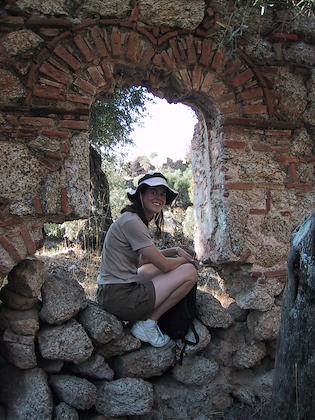 |
| If you look closely, you can see the Byzantine monastery in this picture. | | There were unusual double-arch windows or doorways at the monastery. |
| |
|
 | |  |
| The ruins of the monastery extended over a couple acres. | | This fresco, painted under a rock, would have been impossible to find had we not met an older German couple coming down when we were going up who gave us directions. The overhang of the rock was plastered, and the fresco was applied to the plaster. |
| |
|
 | |  |
| Many of the faces have been partially hacked off. | | Eric took a panorama to get all of the frescos. |
| |
|
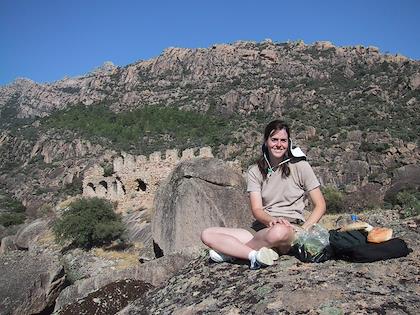 | |  |
| Lunch on the rocks. Lunch usually consisted of a loaf of bread, some cucumbers, tomatoes, cheese, often some apples, and pistachios or some kind of nuts. | | The monks lived in these small cells. |
| |
|
 | |  |
| Very small... | | But with a really good view. Although I imagine this must have been bricked up a little more--it would be too cold otherwise. |
| |
|
 | |  |
| Eric is in the throes of a moral dilemma here. Should he or should he not take a genuine Byzantine brick from the ruins here? | | It's such a pretty brick, too. He eventually decided not to bring it. I think the words that did it were "Midnight Express". |
| |
|
 | | 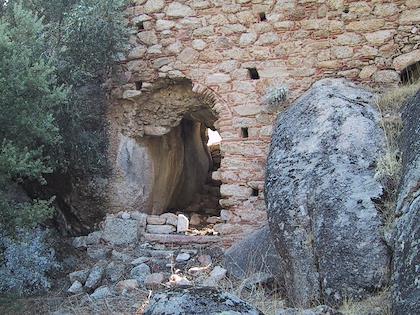 |
| There was quite a drop-off after this arch. | | Much of the monastery was built right on top of the boulders that littered this area. |
| |
|
 | |  |
| A view of the monastery from below, with olive trees. | | Great views on the return trip. |
| |
|
 | |  |
| In this picture you can see Bafa Lake, and the Temple of Athena in Kapikiri if you view the higher resolution picture (click on the picture below to get it). We could hear the call to prayer from the village like it was next door! | | More great views of the lake area. |
| |
|
 | |  |
| The man with the photo had wanted to be our guide up to the monastery, but we had no problem finding it ourselves. The photo he's holding in his hand shows him, pointing out some prehistoric painting that we'd missed along the way. | | Back in Kapikiri, it was time for the cows to go home. |
| |
|
 | | 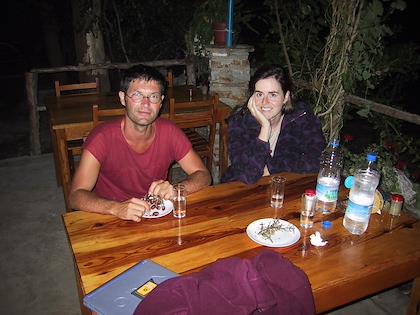 |
| Cows and donkeys are kept right in the middle of ancient ruins. | | We had dinner with Christoph Loehr, the German archeologist who's on a 2 month contract here, cataloging the ruins right around town. It was great to talk to him and ask him all our archeological questions--I wish I'd written them all down! |
| |
|
 | | 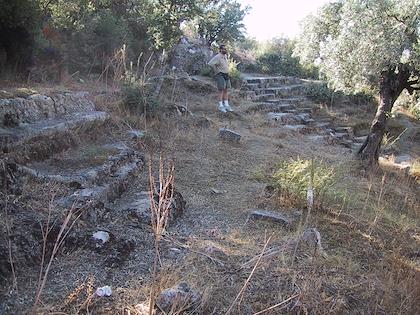 |
| We took a walk around town to see the ruins of Latmos, which we'd missed. On the way we saw this typical Turkish oven. | | Here's the theater. Some of the seats and steps were carved directly into the rock. |
| |
|
 | |  |
| A great view of Kapikiri and Bafa Lake. | | Part of the city wall around the ancient city of Latmos. I wonder why they used this particular pattern, with the narrow stones and then the broad ones. |
| |
|
 | |  |
| The city walls went high up into the hills. It would have been a really fun hike to go up there and try to follow the walls. | | If you look closely, or look at the higher resolution picture (click on the one below) you can see the Temple of Athena and Kapikiri below. |
| |
|
 | |  |
| After Kapikiri, we drove up an unmarked side road, looking for other ruins. Didn't find any, but we did find lots of olive trees, with little stone walls around each of them to prevent the earth from eroding away. | | These are the ruins of Euromos, not too far from Bafa Lake. In this picture you can see both the finished (fluted) and unfinished (unfluted) columns. |
| |
|
 | |  |
| The theater was a little tough to find, but we found it. There isn't much left now, just some seats carved into the rock. | | Another one of the unfinished (and un-worked-on) building around here. This one is outside Milas. |
| |
|
 | |  |
| We went grocery shopping in Milas. Bread is always sold like this, in glass cases outside the stores. | | At the market we bought our usual, tomatoes, cucumbers, and apples. I wish I could pay Turkish prices for fruits and vegetables in the US! This woman is selling persimmons, which I haven't seen in Turkey before. |
| |
|
 | |  |
| | Next we went to the ruins of Labranda, which Christoph, the archeologist, particularly recommended. The views were outstanding. |
| |
|
 | |  |
| | A wide set of steps leads down to what I think is the First Andron (a men's religious gathering place). |
| |
|
 | |  |
| The caretaker/ticket seller had a nice garden right next to the ruins. | | Our best guess at what this was is something like a pipe fitting, where a sewage fixture takes a 90 degree angle. |
| |
|
 | |  |
| The caretaker is drying walnuts on top of his roof. | | Eric is taking a rest inside the Temple of Zeus. |
| |
|
 | |  |
| Looks like the ruins will shortly become even more ruined soon, with these vines tearing them apart.. | | Eric thought this snake was dead, because it didn't move when he threw a small twig at it. Turns out it was just injured, because after he came closer, it hissed at him. The caretaker smashed it with a stick, saying that it was poisonous. |
| |
|
 | |  |
| At home, we posted a question on alt.pets.reptiles.snakes, and were told it's probably an Ottoman viper (Vipera Xanthina), a venomous species found in Turkey. Supposedly extremely rare. | | This Roman tomb had a section above, which was apparently for children. |
| |
|
 | |  |
| Inside the tomb. | | Next to the tomb was a huge boulder with steps carved in it. We climbed up... |
| |
|
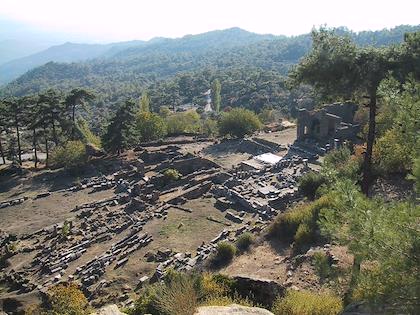 | | |
| And had a great view of the valley. | | |